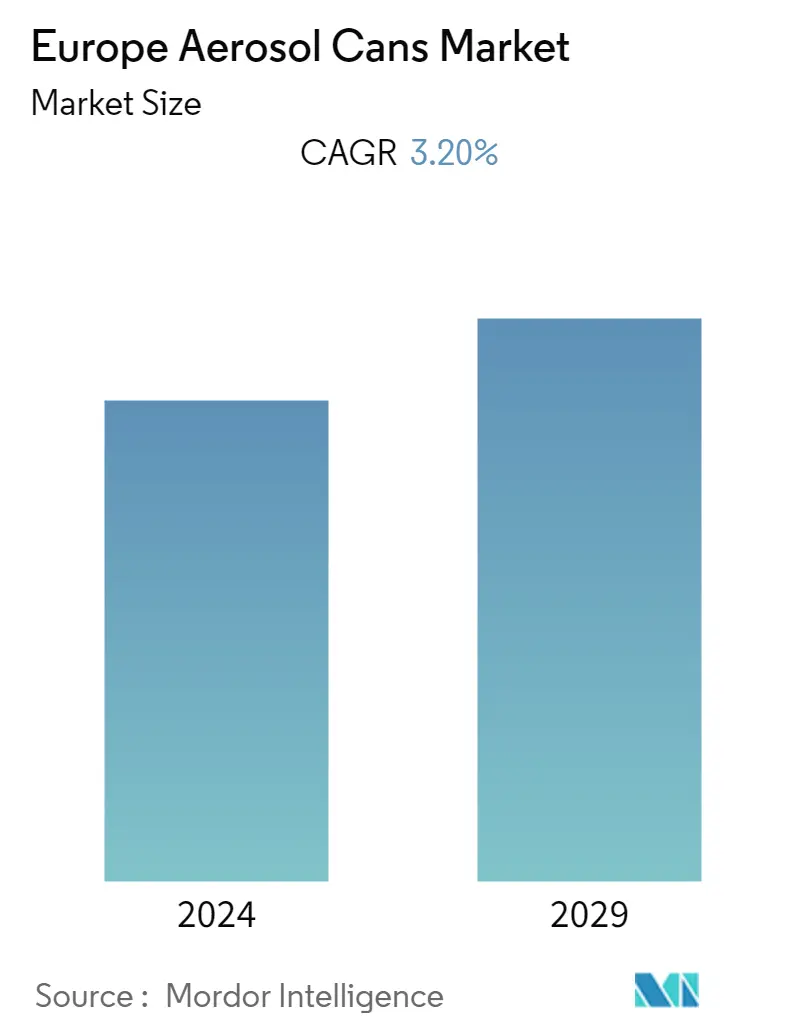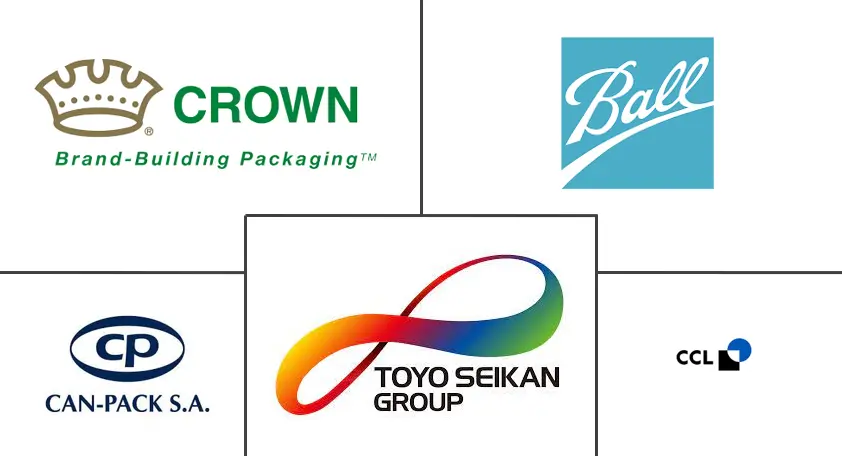Market Size of Europe Aerosol Cans Industry

| Study Period | 2019 - 2029 |
| Base Year For Estimation | 2023 |
| Forecast Data Period | 2024 - 2029 |
| Historical Data Period | 2019 - 2022 |
| CAGR | 3.20 % |
| Market Concentration | High |
Major Players
*Disclaimer: Major Players sorted in no particular order |
Europe Aerosol Cans Market Analysis
The European aerosol cans market is expected to register a CAGR of 3.2% during the forecast period (2021 - 2026). The COVID-19 pandemic is leaving a trail of devastation in its wake in numerous branches of the industry across Europe. Government-imposed curfews and restrictions on mobility, including cross-border movement and companies' complete or partial closures, are causing considerable disruption within the tightly woven international supply chains. In many European countries, packaging has already been identified as a relevant part of the system for supplying the population with food, healthcare, and pharmaceutical products and is exempted from state-imposed restrictions. Consequently, grocery stores, chemists, and pharmacies stay open for business to ensure that the public is supplied with the packaged food, cosmetics, and pharmaceutical products it needs.
- Aerosol offers a wide range of products, from mass-market goods, such as household and cosmetic products, to specific aerosol types dedicated for industrial or medical purposes. The aerosol cans are used for coatings, cleaning agents, air fresheners, personal care items, insecticides, and a host of other products. While the market faced challenges in the early 1990s due to increased concerns about CFC propellants, innovations in spray technologies and the use of eco-friendly propellants have enabled rapid adoption of aerosol cans in multiple industries.
- Europe accounts for a significant share in the market studied due to the increasing demand from the leading European economy's personal care and food segment.
- Moreover, the pharmaceutical sector has been observed to have shown a growing interest in aluminum aerosol cans owing to the can's high level of security, further complemented by its convenient handling. Such factors are expected to add to the demand in the region. The government's push for sustainability and industrial acceptance of the same has been a huge positive impact on aluminum aerosol cans demand in the region.
- The per capita consumption of aerosols in Germany, France, and Russia, is expected to provide more demand during the forecast period. Besides the personal care sector, the pharmaceutical segment is witnessing growth as the aerosol system is tailor-made for a hygienic, safe and precise application of products. Moreover, with many industrial and automotive segments looking for innovative packaging solutions, the consumption of aerosol products from these sectors has increased rapidly, with a wide range of products being packaging in aerosol cans.
- Additionally, increasing investments in infrastructure development and positive economic trends are expected further to support the industrial demand over the forecast period. Moreover, owing to the convenience and strength offered by aerosol packaging, aerosol cans have become the standard packaging used in many industries. Besides, constant innovations by the companies in the market and technological developments in packaging are expected to drive market growth.
- Further, In September 2020, over 85 companies and organizations from the complete packaging value chain, including Beiersdorf, Procter & Gamble, Unilever, L'Oréal, ALPLA, and Henkel, have joined forces to assess whether digital technology can enable better sorting. They also focus on improved recycling rates for packaging in the European Union to drive a circular economy.
- Recently, Ball Corporation unveiled its latest can technology, 360-degree custom shaping, at the ADF & PCD exhibition in Paris. The new technology brought another dimension can contouring, using a process that allows custom shaping, symmetrically or asymmetrically, up to the entire circumference of the can, benefiting both brand owners and end consumers. Furthermore, with regulations specified in laws, directives, or rules, the guidelines of the requirements are also placed in industry, e.g., FEA (European Aerosol Federation) standards.
Europe Aerosol Cans Industry Segmentation
Aerosol cans are used as a packaging product to dispense the contents with the help of a valve. Most cans are made using aluminum, steel, and glass, while the others are made with plastic. The study focuses on key countries in Europe, such as the United Kingdom, Germany, France, Italy, and the Rest of Europe. Further, the report also covers the competitive landscape and an analysis of COVID-19 on the market.
| By Material | |
| Aluminum | |
| Steel-tinplate | |
| Other Materials |
| By End-User Industry | |
| Cosmetic and Personal Care (Deodorants/Antiperspirants, Hairsprays, Hair Mousse, and Others) | |
| Household | |
| Pharmaceutical/Veterinary | |
| Paints and Varnishes | |
| Automotive/Industrial | |
| Other End-user Industries |
| By Country | |
| United Kingdom | |
| Germany | |
| France | |
| Italy | |
| Rest of Europe |
Europe Aerosol Cans Market Size Summary
The European aerosol cans market is experiencing a steady growth trajectory, driven by the increasing demand for aerosol products across various sectors, including personal care, food, and pharmaceuticals. The market's resilience is evident despite challenges posed by the COVID-19 pandemic, which disrupted supply chains but highlighted the essential role of packaging in delivering goods. Aerosol cans, known for their versatility in packaging products such as coatings, cleaning agents, and personal care items, have seen a resurgence due to innovations in spray technologies and the adoption of eco-friendly propellants. The region's commitment to sustainability and the circular economy, supported by government initiatives and industry collaborations, has further bolstered the demand for aluminum aerosol cans, which are favored for their recyclability and convenience.
The market landscape is characterized by a few dominant players, with companies focusing on sustainability and product innovation to maintain competitiveness. The shift towards aluminum cans is particularly notable, as they offer benefits like lightweight, recyclability, and cost-effectiveness, making them a preferred choice in the personal care industry. The market is also witnessing technological advancements, such as digital embellishment services and 3D aerosol configurators, which enhance packaging design and functionality. Additionally, the push for recycling and the use of post-consumer recycled materials are gaining traction, aligning with the broader environmental goals in Europe. These factors, combined with positive economic trends and infrastructure investments, are expected to sustain the market's growth in the coming years.
Europe Aerosol Cans Market Size - Table of Contents
-
1. MARKET SEGMENTATION
-
1.1 By Material
-
1.1.1 Aluminum
-
1.1.2 Steel-tinplate
-
1.1.3 Other Materials
-
-
1.2 By End-User Industry
-
1.2.1 Cosmetic and Personal Care (Deodorants/Antiperspirants, Hairsprays, Hair Mousse, and Others)
-
1.2.2 Household
-
1.2.3 Pharmaceutical/Veterinary
-
1.2.4 Paints and Varnishes
-
1.2.5 Automotive/Industrial
-
1.2.6 Other End-user Industries
-
-
1.3 By Country
-
1.3.1 United Kingdom
-
1.3.2 Germany
-
1.3.3 France
-
1.3.4 Italy
-
1.3.5 Rest of Europe
-
-
Europe Aerosol Cans Market Size FAQs
What is the current Europe Aerosol Cans Market size?
The Europe Aerosol Cans Market is projected to register a CAGR of 3.20% during the forecast period (2024-2029)
Who are the key players in Europe Aerosol Cans Market?
Crown Holdings inc., Ball Corporation, Toyo Seikan Group Holdings, CCL Industries and Can-Pack SA are the major companies operating in the Europe Aerosol Cans Market.

